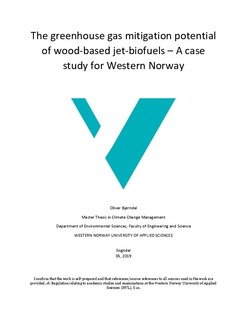| dc.description.abstract | The Norwegian aviation industry has proposed substituting jet-fuels with biofuels based on forest biomass. This can potentially contribute to mitigating the expected increase in greenhouse gas emissions from aviation activity toward 2030. However, retrieving the biofuel feedstocks requires harvesting of forest, and thus the climate system is affected through changes in forests biogeophysical and biogeochemical climate functions. These effects have not been accounted for in assessments of wood-based biofuels in Norwegian aviation, although climate change mitigation is the underlying reason for the proposed strategy. This thesis assesses how the inclusion of one of the forests most important climate functions, the role as a carbon pool, can affect the climate change mitigation potential of wood-based biofuels in Western Norwegian aviation. For this purpose, a simple forest model for Western Norwegian spruce forest is developed, and different scenarios for fuel-use in the aviation sector are explored. When 30 % of jet-fuel sales are gradually replaced by biofuels between 2019 and 2030 (BIO-JET scenario), this leads to 0.6 Mt less of cumulated carbon dioxide equivalent emissions over the period, compared to business as usual. However, considerable temporary reductions in the carbon stored by the forest results in overall 133 % higher temperature response from GHG emissions in 2050 when biofuels are utilized. The warming effect is still 40 % higher in 2100 and will approach 14 % lower towards 2200. In comparison, reducing fuel-use by 30 % between 2019 and 2030 (AVI-RED scenario) leads to 2 Mt less of cumulated carbon dioxide equivalent emissions over the period, and 32 % lower temperature response compared to business as usual. The scenario analysis indicate the potential for mal-mitigation by introduction of wood-based biofuels in the aviation sector, and shows that policy measures targeting demand reduction are very important. This reveals a need for more comprehensive research on the effects of wood-based biofuels, and for the potential options in Norway for utilizing forest management to cope with climate change. | nb_NO |

